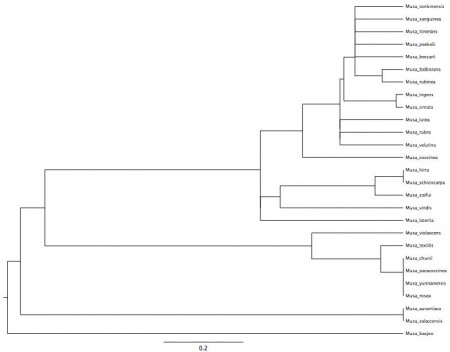PhyloGenerator is “an open-source, stand-alone Python program, that makes use of pre-existing sequence data and taxonomic information to largely automate the estimation of phylogenies.” Sounds intriguing, no? I found out about it via this Twitter exchange with Rich Grenyer:
@rich_ @Phalaropus Sure, of course!
— AgroBioDiverse (@AgroBioDiverse) July 11, 2013
He very kindly shared his automatically generated Musa phylogeny, which is reproduced below. I’m afraid you’ll have to click on the image to read the species names.
So now I’m reaching out to all you banana taxonomists out there. Does this make any sense?

Li et al. (2010): Monophyly of Musaceae family as per phylogenetic analyses, which indicated that Musella and Ensete to be congeneric or closely related. None of the five Musa sections previously defined based on morphology was a monophyletic group but 2 infra-generic clades identified based on basic chromosome numbers; i.e., x = 11 (Musa and Rhodochlamys) and x = 10 (Callimusa), 9 (Australimusa) or 7 (Ingentimusa).
Wikipedia: The World Checklist of Selected Plant Families accepts 68 species and two primary hybrids, as of January 2013, which are listed below] The assignment to sections is based on GRIN (where this gives the species), regrouped according to Wong et al. (2002):
http://en.wikipedia.org/wiki/Musa_(genus)
It does not make sense. There are too many species which have been shown by rigorous genetic analysis to be closely related, which are way off in this phylogeny.
Thanks, both of you. That’s very interesting to know…